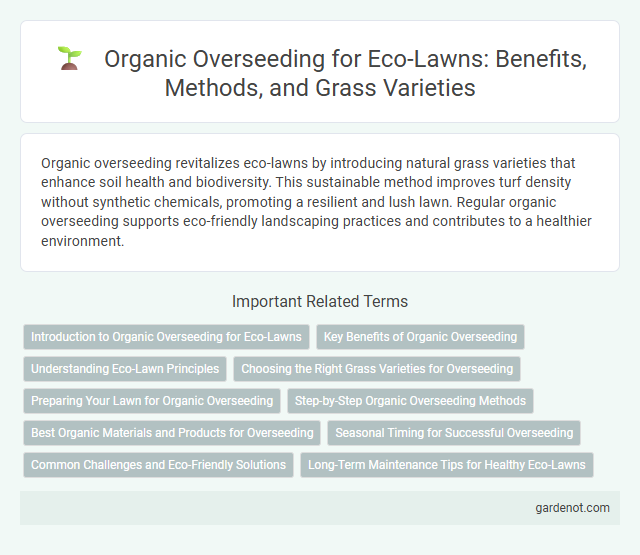Organic overseeding revitalizes eco-lawns by introducing natural grass varieties that enhance soil health and biodiversity. This sustainable method improves turf density without synthetic chemicals, promoting a resilient and lush lawn. Regular organic overseeding supports eco-friendly landscaping practices and contributes to a healthier environment.
Introduction to Organic Overseeding for Eco-Lawns
Organic overseeding enhances eco-lawns by introducing natural, chemical-free grass seeds that promote soil health and biodiversity. This method improves lawn density and resilience while reducing dependence on synthetic fertilizers and pesticides. Using organic overseeding supports sustainable lawn care practices that benefit the environment and create lush, green spaces.
Key Benefits of Organic Overseeding
Organic overseeding enhances soil health by promoting beneficial microbial activity and improving nutrient cycling, leading to a thicker, more resilient lawn. It naturally suppresses weeds and reduces the need for chemical fertilizers and pesticides, supporting an eco-friendly lawn care routine. Improved water retention and drought resistance are additional benefits, making organic overseeding an effective method for sustainable turf management.
Understanding Eco-Lawn Principles
Organic overseeding enhances eco-lawn health by introducing native grass species that improve soil biodiversity and drought resistance. This method promotes natural nutrient cycling and reduces the need for synthetic fertilizers, aligning with sustainable lawn management principles. Understanding eco-lawn principles involves prioritizing ecological balance, water conservation, and minimal chemical inputs to create resilient, low-maintenance turf.
Choosing the Right Grass Varieties for Overseeding
Selecting the right grass varieties for organic overseeding ensures a resilient, eco-friendly lawn that thrives without synthetic inputs. Opt for native or drought-tolerant species like fescues, ryegrass, and bluegrass, which enhance soil health and biodiversity while minimizing water usage. Properly matched grass types improve germination rates and establish a dense turf that naturally suppresses weeds.
Preparing Your Lawn for Organic Overseeding
Preparing your lawn for organic overseeding involves mowing the existing grass short and raking away debris to ensure optimal seed-to-soil contact. Aerating the soil enhances oxygen flow and water absorption, promoting healthy seed germination. Applying a thin layer of organic compost after overseeding provides essential nutrients that support vigorous growth and improve soil structure.
Step-by-Step Organic Overseeding Methods
Start by mowing the existing lawn to a low height and removing any debris or thatch with a rake to create a clean seedbed. Spread a quality organic grass seed evenly over the prepared soil, ensuring good seed-to-soil contact by lightly raking the surface and pressing the seeds into the ground. Water the area gently but thoroughly, maintaining consistent moisture until new grass establishes, which typically takes 2 to 3 weeks for organic overseeding methods.
Best Organic Materials and Products for Overseeding
Using organic overseeding materials like composted cow manure, kelp meal, and finely screened topsoil significantly enhances soil health and seed germination in eco-lawns. Products such as TerraCycle Organic Seed Starter Mix and Espoma Organic Lawn Food provide essential nutrients while promoting beneficial microbial activity for sustainable lawn growth. Incorporating these best organic materials ensures improved moisture retention, reduces chemical dependency, and supports a robust, environmentally friendly lawn ecosystem.
Seasonal Timing for Successful Overseeding
Organic overseeding achieves optimal results when timed to align with the grass growth cycles of each season. Cool-season grasses benefit most from overseeding in early fall when soil temperatures range between 50degF to 65degF, promoting seed germination and root establishment. Warm-season grasses should be overseeded in late spring to early summer, when soil temperatures consistently exceed 70degF, ensuring vigorous growth and weed competition suppression.
Common Challenges and Eco-Friendly Solutions
Organic overseeding often faces challenges such as poor seed germination, weed competition, and soil nutrient deficiencies. Utilizing eco-friendly solutions like natural compost, mycorrhizal fungi inoculants, and organic seed blends enhances seed establishment and soil health. Employing mulch from biodegradable materials and maintaining proper moisture levels further supports sustainable lawn regeneration without harmful chemicals.
Long-Term Maintenance Tips for Healthy Eco-Lawns
Organic overseeding enhances soil health and promotes resilient turf by introducing nutrient-rich compost and natural seed blends specifically designed for eco-lawns. Maintaining proper soil pH between 6.0 and 7.0, utilizing slow-release organic fertilizers, and regularly aerating the soil reduce compaction and improve water infiltration. Consistent mowing at a height of 3 to 4 inches preserves root depth and encourages thicker, drought-resistant grass growth over time.
Organic overseeding Infographic

 gardenot.com
gardenot.com